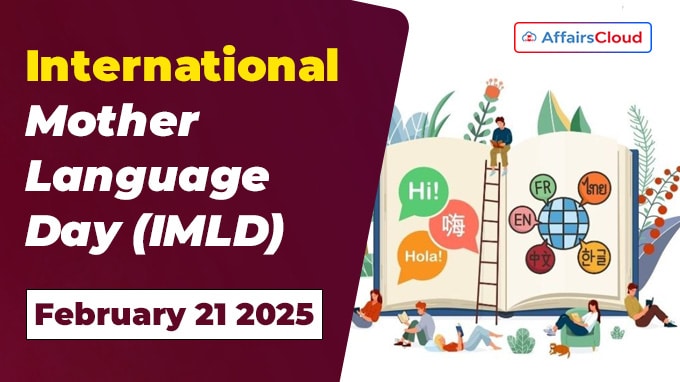 The United Nations (UN’s) International Mother Language Day (IMLD) is observed annually on February 21 across the globe to raise awareness about the importance of preserving and promoting mother languages. The day also aims to promote linguistic and cultural diversity and to encourage multilingualism and highlight the role of languages in fostering a peaceful, tolerant, and inclusive global society.
The United Nations (UN’s) International Mother Language Day (IMLD) is observed annually on February 21 across the globe to raise awareness about the importance of preserving and promoting mother languages. The day also aims to promote linguistic and cultural diversity and to encourage multilingualism and highlight the role of languages in fostering a peaceful, tolerant, and inclusive global society.
- 21 February 2025 marks the observance of the 25th anniversary of IMLD.
- The theme of IMLD 2025: “Languages Matter: Silver Jubilee Celebration of International Mother Language Day,” serves as an important reminder to safeguard linguistic diversity and encourage the use of mother tongues.
Background:
i.The initiative to celebrate IMLD originated in Bangladesh, where it honors the language martyrs who made the ultimate sacrifice during the 1952 language movement in Dhaka, Bangladesh striving to protect the dignity of their mother tongue, ‘Bangla’.
ii.On November 17 1999, the General Conference of the United Nations Educational, Scientific and Cultural Organization(UNESCO) declared February 21 as “International Mother Language Day (IMLD)” to honor the Bengali people’s struggle and sacrifice for their language and culture.
- The first ever IMLD was observed on 21st December 2000, following the proclamation by UNESCO.
v.The United Nations General Assembly (UNGA) further recognized this observance in its resolution (A/RES/56/262) in 2002.
What is Mother Language?
i.A mother language, or native language, is the first language a person learns from birth, spoken within the family and community, and represents the cultural identity of an individual or group.
ii.This language is deeply connected to one’s heritage, traditions, and values, forming a crucial part of their personal and social identity.
International Year of Language:
i.In May 2007, the UNGA adopted resolution A/RES/61/266, urging Member States and the Secretariat to actively promote the preservation and protection of all languages spoken by people worldwide.
ii.This resolution also declared 2008 as the ‘International Year of Languages’, aiming to foster unity in diversity and enhance international understanding through multilingualism and multiculturalism.
- UNESCO was appointed as the lead agency for overseeing the International Year of Languages.
2025 Events:
i.National Event: On the occasion of IMLD, the Indira Gandhi Rashtriya Manav Sangrahalaya (IGRMS), in Madhya Pradesh (MP), an autonomous organization under the Ministry of Culture (MoC) organized a 2-day workshop to promote linguistic and cultural diversity and multilingualism.
- The Sangrahalaya launched the ‘Learn New Languages’ program to encourage regional languages and dialects.
- The workshop focused on teaching basic communication sentences used in daily life in 3 languages (Oriya, Marathi and Bengali).
ii.International Event: As part of the celebration, the UNESCO organized a 2-day event featuring technical dialogues on 20th February followed by, high-level sessions, cultural performances, and an exhibition on 21st February in its headquarters Paris, France.
iii.Other Events: A commemorative event in Tokyo, Japan, co-hosted by United Nations University (UNU) Shibuya, Japan and the Embassy of Bangladesh, celebrated the role of language preservation in creating more peaceful, sustainable societies.
Key Facts:
i.According to the UNESCO’s World Atlas of Languages, there are approximately 8,324 languages, both spoken and signed, documented globally.
ii.Of these, around 7,000 languages are still in use. However, linguistic diversity is under threat, with many languages disappearing at an accelerated pace.
iii.Additionally, UNESCO highlights that 40% of learners lack the opportunity to learn in their mother tongue, which enhances comprehension, engagement, and critical thinking.
iv.Multilingual education boosts participation, retention, and development, while supporting global goals like gender equality, climate action, and sustainability.
Points to Note:
i.Section 29(f) of Chapter V of the Right to Education Act, 2009, stipulates that, “the medium of instruction shall, as far as practicable, be in the child’s mother tongue.”
ii.As per the Unified District Information System for Education Plus (UDISE+) 2020-21, teaching and learning in grades 1-5 are being conducted in 28 languages.
iii.These include Assamese, Bengali, Gujarati, Hindi, Kannada, Konkani, Malayalam, Manipuri, Marathi, Nepali, Odia, Punjabi, Sanskrit, Sindhi, Tamil, Telugu, Urdu, English, Bodo, Khasi, Garo, Mizo, French, Hmar, Karbi, Santhali, Bhodi, and Purgi.
About United Nations Educational, Scientific and Cultural Organisation (UNESCO):
Director-General (DG)– Audrey Azoulay
Headquarters– Paris, France
Established – 1945




